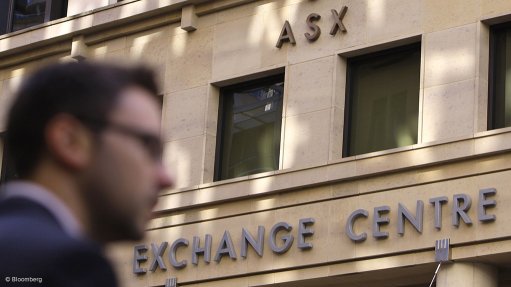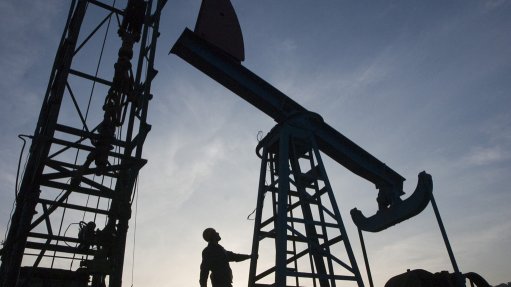Platinum moving into meaningful deficit amid emergent source of new end-demand

World Platinum Investment Council Director of Research Edward Sterck interviewed by Mining Weekly’s Martin Creamer. Video: Darlene Creamer.
JOHANNESBURG (miningweekly.com) – Platinum is moving into meaningful deficit amid an emergent source of new end-demand in the form of green hydrogen.
The 2022 surplus of 804 000 oz is projected to move into a deficit of 303 000 oz in 2023, according to the Platinum Quarterly of the World Platinum Investment Council (WPIC) for the third quarter of 2022.
The surplus in 2022 is largely the result of net disinvestment that reduces substantially going into next year and becomes net positive investment.
Demand for platinum is growing by 19% into 2023, compared with supply growth of only 2%.
While such strong demand growth in a recessionary environment may seem slightly counterintuitive, it is important to remember that the main drivers are automotive demand and industrial demand.
The automotive market remains somewhat suppressed because of supply chain challenges, and it is below recessionary levels of consumer demand, whereas industrial demand is largely the result of capacity additions that have been substantially committed and, in most cases largely complete from a construction perspective.
The other key aspect is that this deficit is arriving after two years of surpluses.
While one might question whether the surplus material from 2021 and 2022 will simply offset the deficit in 2023, WPIC does not believe that will happen, the main reason being that China has been buying significant amounts of platinum, taking up all of the surpluses.
The inventories that have accumulated in China are expected to be highly price sensitive, with considerably higher platinum prices likely to be needed to unlock that platinum for the domestic market.
Green hydrogen then makes up the emergent source of new-end demand, with platinum being a key catalyst in the production and consumption of green hydrogen.
While current demand for platinum from within the green hydrogen economy is relatively small, it is growing quickly, and having an emergent new-end source of demand that is growing quickly is not a feature of many other commodities, with only silver and the photovoltaic demand being a recent comparison.
“In summary, platinum is looking extremely interesting next year moving into a deficit, and we have this emergent source of new end demand as well which could help support platinum demand growth going through into the rest of the decade,” new WPIC director of research Edward Sterck commented to Mining Weekly in a Zoom interview. (Also watch attached Creamer Media video.)
Platinum’s qualities make it valued in automotive, industrial, jewellery and investment sectors. Over the last five years, 73% to 76% of platinum supply in refined ounces has come from primary mining output, with demand from autocatalysis equating to between 31% and 42% of total demand.
Platinum’s non-automotive industrial uses account for 28% of total global demand ditto jewellery demand. Investment demand is the most variable category, ranging between -1% and 20% of total demand, excluding movements in unpublished vaulted investor holdings.
Mining Weekly: Supply is forecast to decline 10% in 2022, and rise by just 2% in 2023. Can you provide more about the reasons for this?
Sterck: The decline in 2022 reflects two things: in 2021 supply was boosted by Anglo American Platinum’s unwinding of that ACP work in progress inventory, and then turning to this year. we've also seen significant challenges in terms of power availability in South Africa, that hampered the ability of the producers in South Africa to sustain output at levels that were planned at the beginning of the year. Looking into 2023, we do have a bit of an increase in supply – 2% – but that assumes that there are still ongoing challenges with power availability in South Africa. Something that isn't taking into account in it are the risks to Russian supply. As things stand at the moment, Russian supply is expected to remain flat year on year, but Nornickel, which is the principal producer of platinum and palladium in Russia, has cautioned publicly that it is struggling with the impacts of sanctions, which are limiting its ability to procure mining equipment, and to procure spares for the mining equipment that it already has, so it is quite possible that Nornickel may struggle to sustain output its historical levels or production going into next year and beyond.
Automotive demand is growing at a steady rate this year and is poised to do the same next year, but the brakes are still on to some extent – why is that?
It really comes down to the supply chain challenges that the automotive industry has been subjected to over the last couple of years and this is principally the semiconductor shortage which is limiting the ability of the automakers to sustain output at planned levels. The supply chain challenges have started to ease and that is expected to continue into 2023. But the automotive production numbers are still a long way below what was expected pre-Covid. We're probably talking around five-million to seven-million vehicles below those pre-Covid projections. The other thing, of course, is that we're seeing increasing penetration from battery technologies and so therefore fewer pure internal combustion engine (ICE) vehicles being produced, but on the other hand, partially offsetting that are the increased number of hybrid vehicles that are being produced. That’s the combination of the ICE and some elements of battery electrification. For platinum demand, hybrid vehicles can have a pretty big impact. They typically contain more PGMs than a plain ICE vehicle, and that's because there's much greater thermal cycling. The exhaust treatment system has to be able to manage reducing emissions even at much lower exhaust system temperatures. There are a number of factors there. I think the demand for platinum from the automotive industry should be set to continue to grow going forwards, partially driven by the increased production of hybrid vehicles, and also higher platinum for palladium substitution in gasoline vehicles. If we look back at the last decade, there was a lot of effort to remove platinum and substitute in palladium and that was on price sensitive factors when palladium was trading below platinum. That situation has now reversed and automakers have been looking to substitute platinum for palladium in order to try and reduce their costs.
Industrial demand is set to expand 10% in 2023, reaching the second highest demand levels on record. What is driving this industrial demand?
There are a couple of factors, but the main one really is capacity additions and predominantly in the glass and chemical space. The industrial demand can go up and down quite significantly. That's because the greatest moment of demand for an industrial facility is when it's first established, and you're loading that facility with the platinum that you need to produce the products that you're trying to manufacture. The ongoing platinum demand requirements thereafter are typically quite small. It’s just replacing any losses that that have occurred through the system. As it happens, for next year, there are quite a lot of capacity additions in the glass and chemical space and those capacity additions are already committed to and in most cases substantially complete from a construction perspective - that incredibly strong industrial demand outlook for 2023 is locked in. The only area I’d caution on is if we do see a particularly deep recession, which is perhaps looking a little bit less likely now, then the rest of demand from industrial space would be more in 2024 and beyond.
The tide is changing for investment demand – going from net disinvestment in 2022, to net investment in 2023. Why is this, and are we starting to see the appeal of green hydrogen becoming more apparent to investors?
Disinvestment over the last 18 months or so has, to a large extent, been a product of two things. Firstly, rising interest rates. For holders of exchange traded funds (ETFs), that are asset class agnostic, they are paying the ETF issuer to manage that position, typically around 0.5%, and the cash equivalent of that investment is not attracting any interest, so effectively they're paying for their exposure to platinum. But with interest rates going up, it's more cost effective for them to switch from holding an ETF into a futures position and then deposit the cash and receive interest on that. Added to that, platinum has been in backwardation since the middle of 2021. That means a holder of a futures position is effectively being paid to hold that speculative position. That's a large part of the ETF disinvestment that we've seen over the last 18 months or so. We expect the pace of that to begin to slow going forward. Effectively, residual holders of ETFs are more likely to hold on to their positions. Perhaps they are not as asset class agnostic as the ones that have just invested so far, and maybe their investment mandates mean that they are restricted to holding ETFs. But also, for some investors, looking at the platinum market swinging into a deficit in 2023, that's quite an attractive outlook potentially and that may encourage them to hold on to their positions. The other significant source of investment outflows has been from exchange stocks. These are inventories held as collateral for positions on the Nymex and take on futures exchanges. We've seen very high yields, so very high lease rates, for platinum over the last 18 months and that reflects a tight physical market, largely because of China's significant imports. The principle here, though, is that with a very high lease rate, owners of the inventories on those exchanges are incentivised to move platinum out of the exchange stocks and then either to lease it out or sell it into the tight physical market. That's attracted a significant amount of material away from the exchange stocks. To put ETFs and exchange stocks together in context, over 1.2-million ounces of ETFs and exchange stocks have been disinvested over the past 18 months – a significant driving force behind the surpluses we reported for 2021 and 2022. And then turning to green hydrogen, the outlook for green hydrogen is really exciting. It’s going to be a key component in terms of trying to decarbonise the world and meet the target sets in the Paris Accord. We've run some numbers on it, and if all the plans come to fruition, as they're currently projected to, we could be looking at somewhere around 10% of global decarbonisation efforts can be met with green hydrogen, so really, really important, and potentially over time a significant end source of platinum demand.
The latest Platinum Quarterly mentions imports into China totalling 1.2-million ounces of platinum, which are far in excess of identified demand. How does this affect the overall picture for platinum?
The 1.2-million ounces is the number that's excess of identified demand in China. Total imports have been significantly more than that. We think there are three reasons behind those excess imports. The first is that Chinese end-users of platinum have been quite aware that the platinum market was likely to enter a deficit at some point in the future and so they may well have been building buffer inventories to protect themselves against the possibility of either supply shortfalls or significant price increases. Secondly, whilst building those buffer inventories, they may well have taken the position that if the market is going to be entering a period of tightness, why not build up those inventories even further on a quasi-speculative basis expecting price increases that they can then benefit from if they then sold that platinum into the open market in China. The third reason is that real end use of platinum may in fact have been somewhat higher than we can currently identify. At present, it's still pretty difficult to get into China and as a result, the data discovery process can be somewhat challenging and having a high degree of certainty that loadings on heavy duty vehicles, for example, are, as projected, quite difficult. It’s certainly interesting to note that when you look at the timing between the big pick-up in excess imports into China, and then the introduction of China six emissions regulations, they happened basically around the same time, so it's certainly possible that part of the excess imports may be true consumption and not inventory building.
What, in your view, should be the biggest takeaway from the latest Platinum Quarterly of the World Platinum Investment Council?
The biggest takeaway should be that the market is moving into a meaningful deficit, and that the availability of above ground inventories is severely restricted and unlikely to offset that deficit in the rest of the world excluding China Within China, it is only likely to be offset if we see significantly higher platinum prices than we have today, which would then attract that inventory back into the markets. So, a meaningful deficit in 2023.
Article Enquiry
Email Article
Save Article
Feedback
To advertise email advertising@creamermedia.co.za or click here
Press Office
Announcements
What's On
Subscribe to improve your user experience...
Option 1 (equivalent of R125 a month):
Receive a weekly copy of Creamer Media's Engineering News & Mining Weekly magazine
(print copy for those in South Africa and e-magazine for those outside of South Africa)
Receive daily email newsletters
Access to full search results
Access archive of magazine back copies
Access to Projects in Progress
Access to ONE Research Report of your choice in PDF format
Option 2 (equivalent of R375 a month):
All benefits from Option 1
PLUS
Access to Creamer Media's Research Channel Africa for ALL Research Reports, in PDF format, on various industrial and mining sectors
including Electricity; Water; Energy Transition; Hydrogen; Roads, Rail and Ports; Coal; Gold; Platinum; Battery Metals; etc.
Already a subscriber?
Forgotten your password?
Receive weekly copy of Creamer Media's Engineering News & Mining Weekly magazine (print copy for those in South Africa and e-magazine for those outside of South Africa)
➕
Recieve daily email newsletters
➕
Access to full search results
➕
Access archive of magazine back copies
➕
Access to Projects in Progress
➕
Access to ONE Research Report of your choice in PDF format
RESEARCH CHANNEL AFRICA
R4500 (equivalent of R375 a month)
SUBSCRIBEAll benefits from Option 1
➕
Access to Creamer Media's Research Channel Africa for ALL Research Reports on various industrial and mining sectors, in PDF format, including on:
Electricity
➕
Water
➕
Energy Transition
➕
Hydrogen
➕
Roads, Rail and Ports
➕
Coal
➕
Gold
➕
Platinum
➕
Battery Metals
➕
etc.
Receive all benefits from Option 1 or Option 2 delivered to numerous people at your company
➕
Multiple User names and Passwords for simultaneous log-ins
➕
Intranet integration access to all in your organisation

















